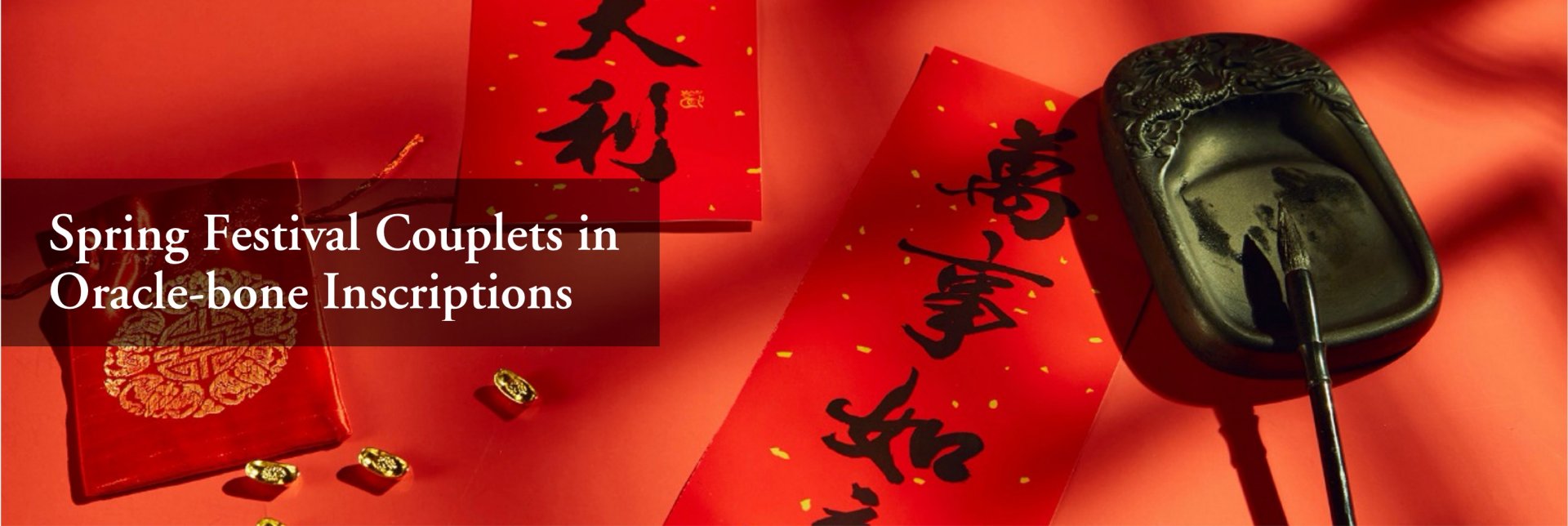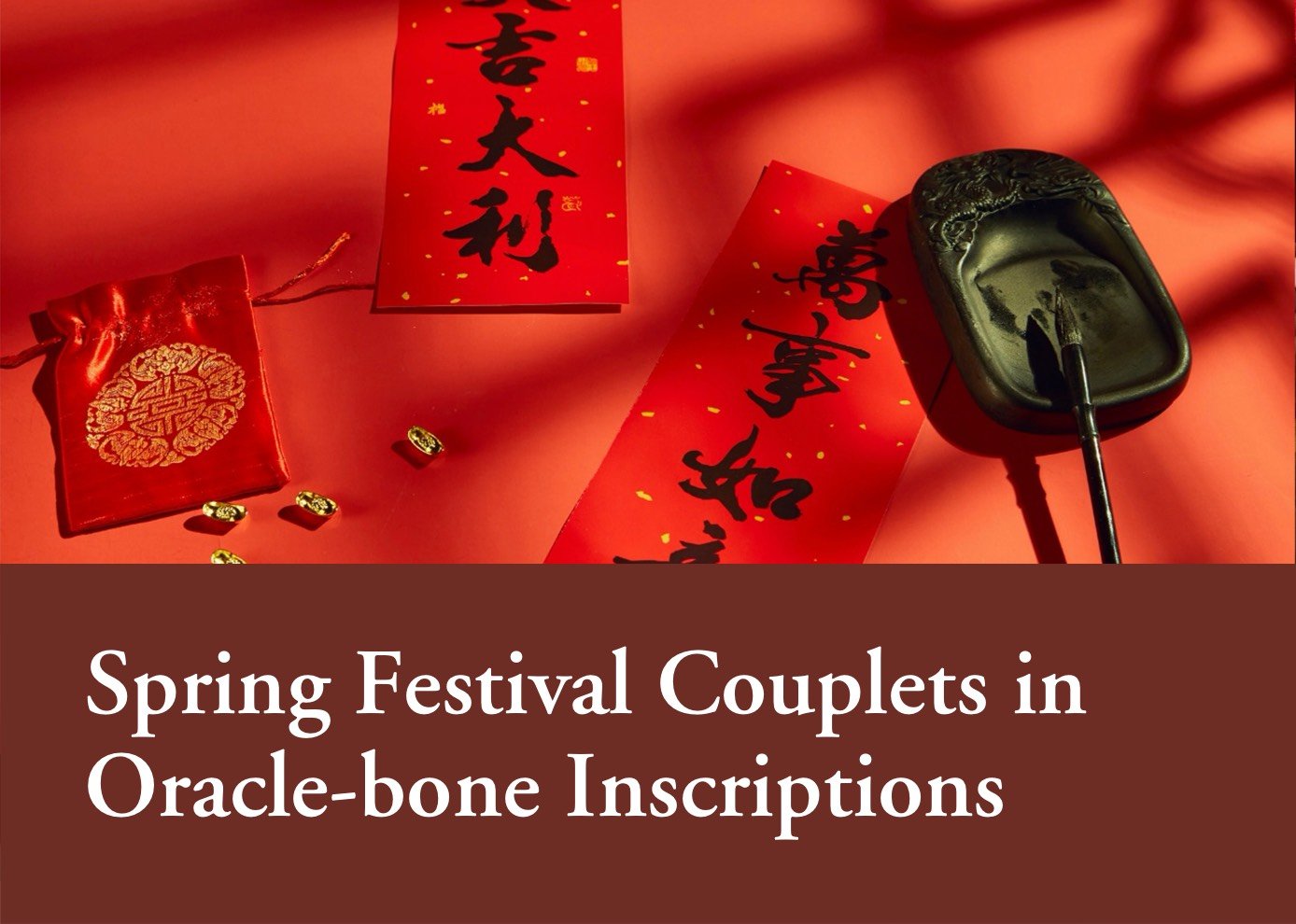Spring Festival Couplets in Oracle-bone Inscriptions
The Origin of Spring Festival Couplets
Spring Festival couplets (春聯, Chunlian) are one of the traditional customs in China, which originated from peach wood charms to drive away evil spirits. Legend has it that in ancient times, there was an extremely fierce monster that often came out to harm the people, and everyone suffered deeply from it. But there was no way to subdue it. Later, two immortals, Shentu (神荼) and Yulei (郁壘), who specialized in eliminating demons, made the monster subdued using peach wood charms and got rid of the harm for the people.
The people showed their gratitude and admiration to the two immortals. In order to pray for permanent peace, some of them got a sudden idea and hung peach wood charms carved with the names of the two immortals on their doors, so that no monsters dared to come forward. Later on, everyone copied this and hung charms on their own doors.

Peach wood charms continued to develop into two rectangular peach wood boards hanging on both sides of the gate, measuring six inches (20cm) in length and three inches (10cm) in width. Then, in the Five Dynasties (907-960) and Ten States (902-979) period, after several rounds of evolution, peach wood charms developed into Spring Festival couplets. After the popularity of paper, the peach wood were finally replaced with red paper.
It is the Emperor Zhu Yuanzhang (朱元璋,1328-1398) of the Ming Dynasty that popularized Spring Festival couplets in a real sense. Recorded in A Miscellany of Zanyun Tower (《簪雲樓雜說》, Zanyunlou Zashuo) by Chen Shanggu (陳尚古,unknown year of birth and death) of the Qing Dynasty (1616-1911), Zhu Yuanzhang had a great fondness for Spring Festival couplets. Once, as the New Year approached, he had a sudden idea and ordered a pair of Spring Festival couplets to be pasted on each door for the festive atmosphere. From then on, Spring Festival couplets have been a must for thousands of millions of households.
The Meanings of Spring Festival Couplets
Spring Festival couplets bear the initial intention of pursuing good luck and driving the evil, and later hoping for a better tomorrow, all of these express the Chinese people’s yearning for a better life. People are very aware of various obstacles and difficulties in real life, so the meaning of life lies in overcoming the obstacles and difficulties through our own efforts. Therefore, we must muster our spirit and move forward with all our might for the future of ourselves, our families, and our nation. When the new year approaches, we must remain steadfast in our goals and not be afraid of difficulties. So we place our beautiful aspirations in the Spring Festival couplets.
Chinese people believe that tomorrow will be better than today since we put in effort today and we do not yield to difficulties. At the beginning, we use peach wood charms to avoid danger, but later we use words of charms to convey our message. It can be seen that words must carry certain powers. During the Chinese New Year, almost every household will paste Spring Festival couplets with all the beautiful words, hoping for successful career, harmonious family, and great fortune.
The Basic Rules of Spring Festival Couplets
Firstly, the position of the first and second lines of the couplets. Facing the couplet, the first line comes on the right-hand side and the second line on the left.
Secondly, the tonal patterns of the couplets. The last character in the first line is in oblique tones (e.g. the falling tone), while the last character in the second line is in level tones (e.g. the rising tone). Note: In ancient phonetics, the character “fu” (福, the most common word meaning “good fortune” or “happiness”) has an oblique tone.
Thirdly, the number of characters in the couplets. In general, odd numbers are preferred because odd numbers are considered as positive numbers in Chinese culture. For example, the following Spring Festival couplet written in oracle-bone inscriptions has seven characters in each line. And there are other couplets with nine or eleven characters.

The First Line: The New Year of Jiachen brings good fortune and happiness.
(上聯:甲辰新春人多福)
The Second Line: The Year of the Dragon introduces literary talents and prosperity.
(下聯:龍年文興財入門)
The Horizontal Scroll to match the couplet: Harmony and Good Fortune.
(橫批:家和事吉)
Here is the explanation. The coming lunar new year is the Year of the Dragon and the Year of Jiachen in traditional Chinese chronology. The Chinese New Year marks the beginning of spring, the beginning of a new year. With many blessings, we hope that we can achieve great wealth, prosperity and happiness in the Year of the Dragon. The “literary talents” (文) in the second line represent culture, characters, and civilization. According to the Book of Changes (《周易》), the Year of the Dragon is suitable for the development of cultural undertakings. Therefore, it is hoped that more friends will be engaged in cultural and educational undertakings next year to truly achieve financial prosperity. In Chinese culture, people value both virtues and talents. It is nothing wrong for people to make money, but it is more important to have a balance of virtues and talents. The cultural and educational undertakings aim to improve one’s virtues, and as one’s virtues improve, he will naturally invite more financial opportunities. The horizontal scroll “Harmony and Good Fortune” bears the hope that everyone in the family is healthy for the first place, and secondly fortunate for their work and career. This is the meaning of the scroll of the couplets.

All articles/videos are prohibited from reproducing without the permission of the copyright holder.




Welcome to leave a message:
Please Sign In/Sign Up as a member and leave a message👏
#1
Lin Luo
08-02-2024 08:02:49